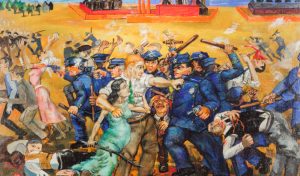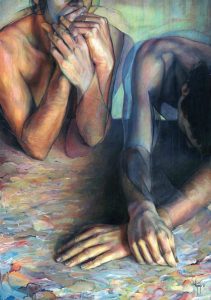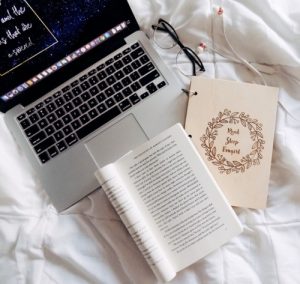Philip Evergood’s An American Tragedy (1937) is a chaotic composition depicting a violent clash between police officers and citizens. The limbs of the depicted human figures are positioned in vertical, horizontal, and diagonal directions. Only the police wield weapons in their hands, in the form of batons or guns, save for the female figure wearing an aqua-colored dress. She holds a long stick in her hand, yet it is her left fist that is raised.
Also striking is the composition of the figures: the horizon line is almost seated at the top edge of the canvas. Most of the officers and citizens are tightly squeezed at the forefront of the scene, their bodies occupying about three-fourths of the height of the canvas. The humans do not appear as naturalistic as the figures in Classical art. They are not abstract either, but their features become significantly less clear as they are positioned closer to the background.
Still, color choices are consistent across the oil painting. The bold blue color of the police uniforms is overwhelming and pops against the yellow ground. Other prominent and distinct colors include green, red, and white. The aqua dress leads the viewers’ eyes to the green tie of the man behind her and up to the trees in the background. Red is centered in the background and also scattered in the form of blood. White smoke runs horizontally from one end of the canvas to the other.
The use of so many bold colors heightens the chaotic nature of the depicted scene. It is as if the colors are still fighting to be the most prominent hue. As practically every area of the work is painted with rich hues, every component of the artwork appears that much more important.




